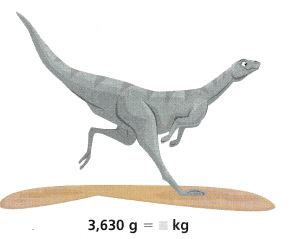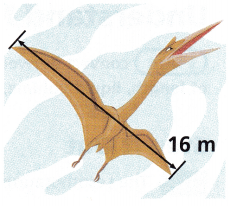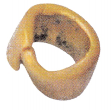We included HMH Into Math Grade 5 Answer Key PDF Module 18 Lesson 1 Understand Metric Conversions to make students experts in learning maths.
HMH Into Math Grade 5 Module 18 Lesson 1 Answer Key Understand Metric Conversions
I Can convert between any two metric units of length, liquid volume, or mass.
Step It Out
Question 1.
The Lesothosaurus was one of the smallest dinosaurs. It had a mass of about 3,630 grams. About how many kilograms was the mass of a Lesothosaurus?

You can use a conversion table to help you.

Answer:
3.630 kg
Explanation:
1000 grams = 1 kg
3630 grams = 3.630kg
A. Compare grams and kilograms.
How many factors of 10 separate grams and kilograms?
Answer:
3
Explanation:
Kilo to Hecto 10
Hecto to Deca 10
Deka to gram 10
3 factors separate grams and kilograms
How many grams are in one kilogram?
Answer: 1000
Explanation:
1000 grams = 1 kg

B. To convert from grams to kilograms, are you converting from a smaller unit to a larger unit or from a larger unit to a smaller unit?
Answer:
a smaller unit to a larger unit
Explanation:
1 kg is equal to 1000 grams
so, we are converting from smaller to larger.
grams are smaller unit and kg are lager unit

C. What operation will you use to make this conversion? ______
3,630 g ![]() _________ = ___________
_________ = ___________
Answer:
Division operation will use for converting grams to kg.
3,630 g ÷ 1000 = 3.630kg
D. About how many kilograms was the mass of the Lesothosaurus?
Answer: 3 koligrams
Turn and Talk How would the conversion be different if you were converting from kilograms to grams?
Answer: converting from kilograms to grams use multiplication.
Question 2.
The largest wingspan for a dinosaur belonged to a species of Quetzalcoatlus. What was the wingspan in millimeters? What was the wingspan in kilometers?

Use a conversion table to help you. The decimal point is shown in 16 meters.

A. To convert the measure to millimeters, shift the decimal point to the location for a unit of millimeters. How many places and in which direction do you shift the decimal point?
Answer: shift the decimal point to 3 places in right hand side direction.
Explanation:

B. After shifting the decimal point, write zeros as needed to write the number of millimeters. What was the wingspan of the dinosaur?
Answer: 16000 millimeters
Explanation:
shift the decimal point to 3 places in right hand side direction., so it is 16000

C. To convert the measure to kilometers, shift the decimal point to the location for a unit of kilometers. How many places and in which direction do you shift the decimal point?
Answer: shift the decimal point to 3 places in left hand side direction.
Explanation:

D. After shifting the decimal point, write zeros as needed to write the number of kilometers. What was the wingspan of the dinosaur?
Answer:
0.016 km
Explanation:
shift the decimal point to 3 places in left hand side direction., so it is 0.016km

Turn and Talk What mathematical operation can you use to convert a measure from meters to millimeters? From meters to kilometers? How do you know?
Answer:
multiplication will use to convert a measure from meters to millimeters
Division will use to convert a measure from meters to kilometers
Check Understanding
Question 1.
The longest dinosaur, the Argentinosaurus, measured 40 meters long. How many centimeters long was the Argentinosaurus?
Answer: 4000 centimeters
Explanation:
Convert 40 meter to centimeters
1 meter = 100 centimeters
40 meters = 40 X 100 centimeters = 4000 centimeters
Convert.
Question 2.
37 hL to L
Answer: 3700 L
Explanation:
37hL= 
Convert to L

So it is 3700L
Question 3.
261.9 cm to m
Answer:
2.619 m
Explanation:
261.9 cm =

Convert to m – shift decimal 2 place to left

Question 4.
9\(\frac{3}{4}\) g to mg
Answer:
1 gram = 1000 milligrams.
9\(\frac{3}{4}\) x 1000
\(\frac{39}{4}\) x 1000
39\(\frac{1000}{4}\) = 39 x 250 = 9750mg.
On Your Own
Question 5.
Social Studies Archaeologists recently dug up what may be the world’s oldest golden artifact in southern Bulgaria. This gold bead has a mass of 150 milligrams and measures 4 millimeters in diameter.

How many grams is the mass of the bead?
Answer: 0.15 grams
Explanation:
gold bead has a mass of 150 milligrams and convert to grams
150 ÷ 1000 = 0.150grams
How many centimeters is its diameter?
Answer: 0.4 cm
Explanation:
gold bead measures 4 millimeters in diameter and convert to centimeters
4 ÷ 10 = 0.4 centimeters
Question 6.
Model with Mathematics Complete the equations to show how to convert 8.25 meters into the given unit of measure.
8.25 m × __________ = _________ dm
8.25 m × __________ = _________ cm
8.25 m × __________ = _________mm
Answer:
8.25 m × 10 = 82.5 dm
8.25 m × 100 = 825 cm
8.25 m × 1000 = 8250 mm
Explanation:
1 m = 10 dm then 8.25 m × 10 = 82.5 dm
1 m = 100 cm then 8.25 m × 100 = 825 cm
1 m = 1000 mm then 8.25 m × 1000 = 8250 mm
Convert.
Question 7.
4.6 m to cm
Answer:
460 cm
Explanation:
1 meter = 100 cm
so, multiplying 4.6 by 100
that is equals to 460.
Question 8.
1.8 L to mL
Answer:
1800 ml
Explanation:
1 liter = 1000 ml
so, multiplying 1000 by 1.8
that is equal to 1800 ml.
Question 9.
58 g to kg
Answer:
0.58kg
Explanation:
1 kg = 100 g
we have to divide 58 by 100
that is 0.58kg
Question 10.
6,257 mL to L
Answer:
6.257
Explanation:
1 liter = 1000 milliliter
we have to divide 6257 by 1000
6257 divided by 1000
is 6.257
Question 11.
22.351 hg to mg
Answer:
22.351 hectogram = 2235100 milligram
Explanation:
1 hg = 100000 mg
so, we have to multiply 22.351 by 100000 mg
2235100 milligram
Question 12.
84\(\frac{1}{2}\) km to m
Answer:
84\(\frac{1}{2}\) km = 84500 m
Explanation:
84\(\frac{1}{2}\)
\(\frac{169}{2}\) x 1000
= 84500 m
multiply the length value by 1000
On Your Own
Question 13.
STEM There is a theory that the dinosaurs may have become extinct as a result of an asteroid crashing into Earth. The impact is believed to have left a crater in what is now the Yucatan Peninsula in Mexico. About how many meters wide is the crater?

Answer:
the crater is 150000 m wide.
Explanation:
The crater is about 150 km
we have to convert 150 km to meter
150 x 100 = 150000m
Question 14.
Reason Are there less than 100,000, exactly 100,000, or greater than 100,000 milliliters in 1 kiloliter? Explain.
Answer:
greater than 100,000 milliliters in 1 kiloliter
Explanation:
multiply the volume value by 1e+6
1 kiloliter = 1000000
Question 15.
Two athletes are training for a long-distance race. Chris runs 2.75 kilometers 6 times each week. Kelly runs 1,250 meters 15 times each week. Whose training involves running a greater total distance each week? By how much more?
Answer:
Kelly runs more.
Explanation:
Chris runs 2.75 kilometers 6 times each week.
2.75 x 6 = 16.5 km
let us convert km to meters
16.5 x 1000 = 16,500meters
Kelly runs 1,250 meters 15 times each week.
1250 x 15 = 18750meters
18750 – 16500 = 2250 meter more
Question 16.
The largest dinosaur eggs had a liquid volume of 3\(\frac{4}{5}\) liters. How many milliliters is this?
Answer:
Explanation:
3\(\frac{4}{5}\) liters.
we have to convert this to milliliters
1 liter = 1000 ml
3\(\frac{4}{5}\) x 1000
\(\frac{19}{5}\) x 1000
= 3800ml.
Question 17.
Attend to Precision The average adult human body contains about 40 liters of fluid. If you want to give this amount as 40,000, what unit of measure do you use?
Answer:
milliliters
Explanation:
The average adult human body contains about 40 liters of fluid.
If you want to give this amount as 40,000,
40 liters converted to milliliters
40 x 1000 = 40,000 milliliters.
Question 18.
Use Structure For any metric unit, how do you convert from milli- to centi-?
Answer:
we just need to multiply the number by 0.1.
Explanation:
we know that one Milli is equivalent to 0.1 Centi
so, we just need to multiply the number by 0.1.
Question 19.
Use Structure For any metric unit, how do you convert from kilo- to either gram, meter, or liter?
Answer:
we have to multiply by 1000
Explanation:
1 kilogram = 1000 grams
1 liter = 1000 ml
1 kilogram (kg) is equal to 1000 grams (g).